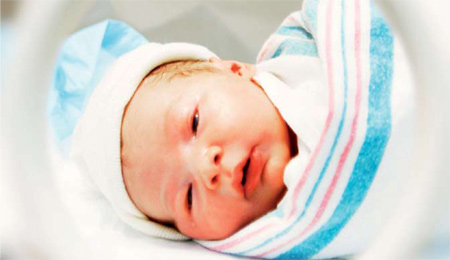Jaundice refers to a yellowish discoloration of the whites of the eyes (sclerae), skin, and mucous membranes. When this occurs in the first month of life, it is called neonatal jaundice. Jaundice occurs in 50-60% of babies within their first week and it is so common that parents often overlook the dangers or complications that may arise.
Common Jaundice in Babies
When old red blood cells are broken down, bilirubin is generated and released into the blood stream. This bilirubin is carried to the liver where it is processed and then removed from the body through stools. Thus, if there is increased breakdown of red blood cells or if the liver is not capable of processing the bilirubin, jaundice ensues.
Before birth, bilirubin is passed through the placenta to be processed and removed by the mother. Just after the baby is born, his liver takes over the job, but this may take a bit of adjusting to and therefore the levels of bilirubin are always higher in newborn babies. The high levels of bilirubin cause the skin to carry a yellowish tinge, which usually appears and peaks between day 2 and day 4 and clears within two weeks. This is known as physiological jaundice. It is the most common cause of neonatal jaundice and is usually harmless to your baby.
Dangerous Jaundice: Pathological Jaundice
Some cases of jaundice are potentially fatal. Pathological jaundice is the rapid onset of jaundice within the first 24 hours of a baby’s life and is caused by excessive breakdown of red blood cells. This in turn, leads to a rapid elevation of the bilirubin level, as the baby’s liver is unable to process the bilirubin fast enough.
The breakdown of red blood cells is excessive and can be caused by various factors such as infections in newborns, incompatibility of mother’s and baby’s Rhesus blood group or a deficiency of a metabolic enzyme (glucose-6-phosphate dehydrogenase) for red blood cell metabolism. In more serious cases, seizures or changes in muscle tone may occur and if not treated immediately, permanent brain damage or even death can occur. Hence, it is very important to seek medical advice early when your baby has jaundice.
Reducing the Jaundice Level
There are various ways that your doctor may use to reduce jaundice such as:
- Phototherapy, which consists of a special light that can break down bilirubin in the skin, so that it can be easily excreted in bile or urine.
- Exchange transfusion, which is a process whereby the baby’s blood is repeatedly withdrawn in small amounts and replaced with a donor’s blood.
A Sign of Obstructive Liver Disease
When baby’s stools are paler than normal, sometimes completely white, it can be a sign of serious underlying medical conditions. These conditions can cause partial or complete obstruction of the biliary tract, which are the ducts that connect the liver to the gut. Examples include viral hepatitis, an inflammation of the liver caused by viruses, and extrahepatic biliary atresia, which is the absence of the bile ducts between the liver and gut.
What to Look Out for?
If your baby is experiencing any of the following symptoms, bring him to the doctor immediately:
- Colour of the stools. Baby’s stools are pale white, grey or pale yellow while the colour of his urine is dark.
- Extensive yellow skin. Skin becomes more yellow, starting from the face and eyes, continuing to the chest, stomach and eventually legs.
- Lethargy. Baby is listless, sickly and lethargic.
- Duration of jaundice. Jaundice that lasts more than three weeks.
- Weight loss. Poor feeding and loss of weight, or does not gain weight.
- Seizures. Baby is irritable and fitting.
Do not take for granted that jaundice is something so common that it does not require much medical attention. Instead, pay close attention to the different symptoms of jaundice that your baby may show. It may be a sign of a more serious underlying medical condition.






Comments